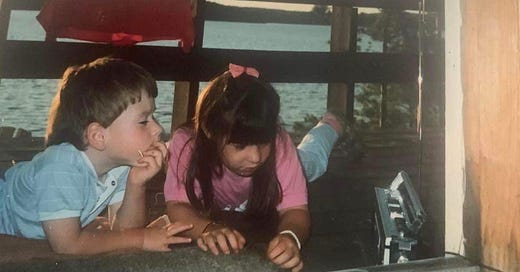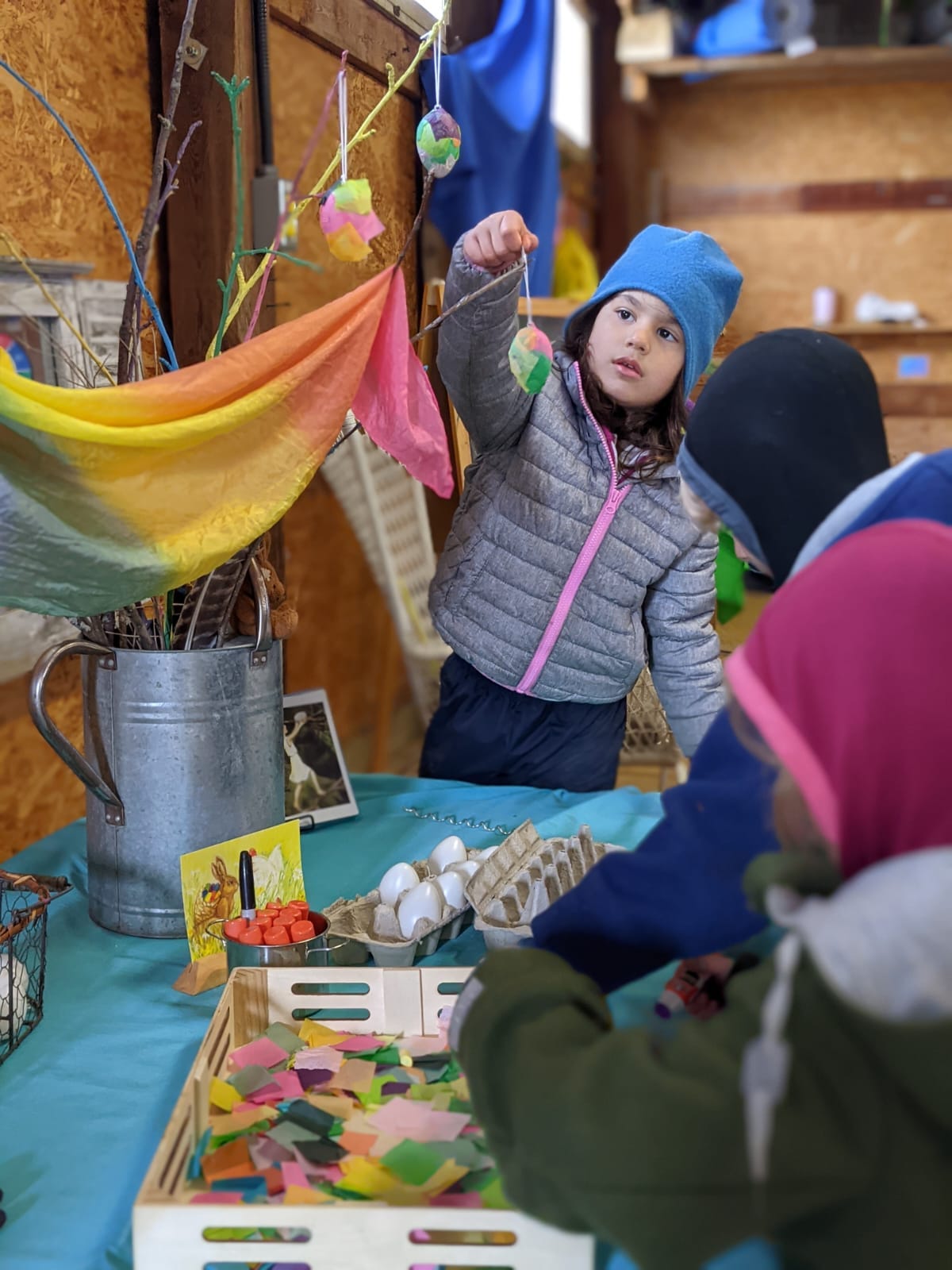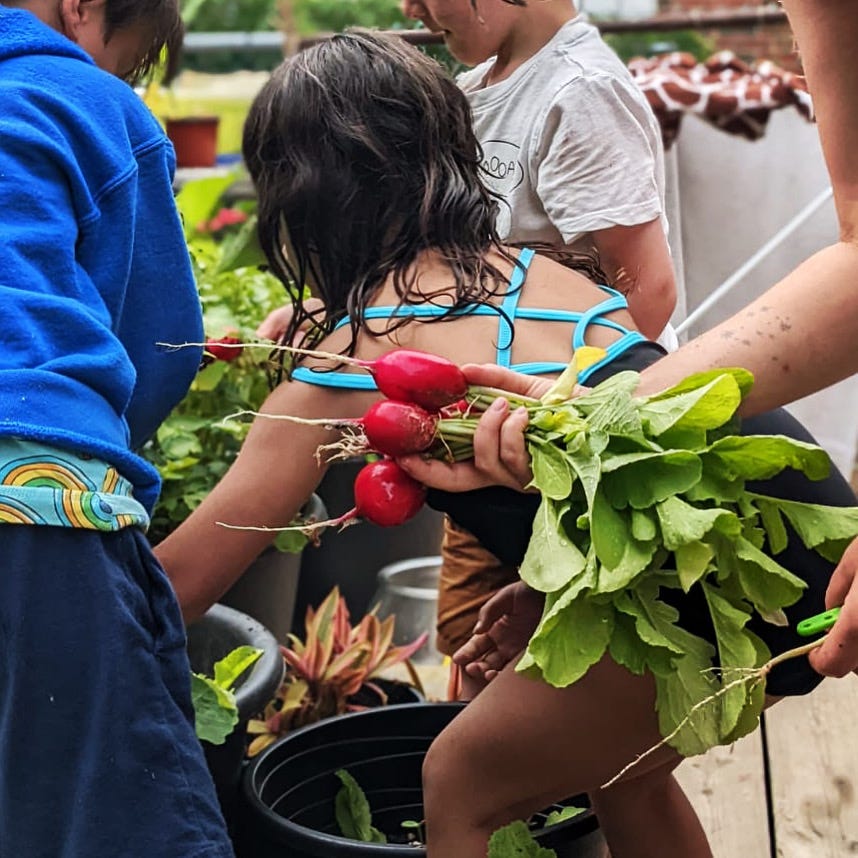Finding enjoyment in working together and learning together is at the heart of any successful homeschool day, wherever we may be.
We’ve been working our way through Lavender Blue’s Kindergarten curriculum for the past two years. Every week, I have to prepare. I prepare a morning circle. I prepare weekly lessons that centre around a story. I rehearse and memorize that story, and then figure out how to present it. Every story has an accompanying activity that also needs preparation. These stories have meaning and metaphors. They are selected carefully for the age of the child, to imbue a sense of wonder and also instil a series of morals and life lessons. Many of our activities centre around purposeful work; lessons are carefully interwoven during moments weeding the garden together, or even while doing dishes. Flexibility is inherent to the curriculum, but I find we do best when we get in the groove and stay consistent.
I thought this week I’d write a little about my journey to Waldorf Education and how Waldorf and World Schooling differ and compliment each other in philosophy.
I started attending Parenting Classes at the Toronto Waldorf School when my daughter Zazie was about a year old. My gateway into Waldorf was actually my passion for permaculture and biodynamics. Prior to Zazie’s birth, I earned certificates in Edible Food Forests and Permaculture through the livinghEARTH permaculture school. I’d learned a bit about the philosophies of anthroposophy through the “Nourishing Traditions” series by Sally Fallon. Even though I was so eager to get pregnant, I was terrified of getting pregnant with a spina bifeda baby. My brother had been born with spina bifeda and I had had a lot of health problems growing up as a kid. My family line carries a series of genetic diseases that prevent the body from properly absorbing and utilizing collagen and folic acid. A double whammy. It’s caused a lot of health issues for me, especially in my late twenties. My brother Tim died as a child from complications of spina bifeda and Arnold-Chiari.
When I read the work of Weston Price, it changed my life. Staring at the pictures of chronically ill children, I saw my brother’s face staring back at me. My brother’s physical deformities were extreme and life-threatening. His body just couldn’t keep up. The experience made me really, really scared of having a spina bifeda baby.
In preparation for conception, I went full Weston Price. Animal livers, cod liver oil, pastured butter, fermented vegetables, steamed greens, and soaked grains became my inner focus. I had a healthy pregnancy and a successful home birth.
After I had my daughter in 2018, I spent a lot of time alone in Etobicoke. My husband was away for weeks at a time shooting a documentary series in the US. I was seeking community, but having a hard time finding it.
I enrolled in Toronto Waldorf School’s Parent and Tot classes in the fall of 2019 in an effort to make friends, but I found it really hard to connect. They were lovely mothers, but they weren’t looking for friends. I remember hanging around the weekend Farmer’s Market, lingering while bouncing baby Zazie in a carrier, aimlessly wandering around hoping to bump into other like-minded mom’s. One afternoon I asked the Farmer’s Market Manager if she knew of any other young mom’s at the school she could connect me to. She smiled widely, shrugged, and stated proudly, “Oh, I’m not really sure. I’m a homeschooler.” It was the first time that I had really heard anyone state so proudly that they were a homeschooler. She went on to tell me her children were grown now, over eighteen, and that she’d Waldorf Homeschooled their entire education.
My mind was blown. People could do that?
I still couldn’t imagine homeschooling because obviously, I had to work. My work previously had been hours and hours spent on film and television sets or in a production office, but now I didn’t want to be away from Zazie for 12 hours a day. I thought how wonderful it would be to actually get paid to be a Waldorf teacher. I enrolled in the Foundations program at the Rudolf Steiner College with a plan to specialize in Early Years. I started Long Distance Learning with Elyse Pomeranz.
In March of 2020, the pandemic hit.
As terrible as Covid was, there were many miracles that time at home brought me.
One of the greatest gifts was simply, time. I was home with my daughter and husband. Those first years were so bizarre. Between 2020 and 2022, we changed as people. Our perspectives shifted dramatically, and we forged a closer bond as a family unit. I was able to consider the benefits of homeschooling in a whole new light. By 2022, the number of homeschoolers in Canada had more than doubled. Homeschooling didn’t seem that crazy, anymore.
I was lucky enough to join two incredible homeschool groups. Teaching children alongside mentors, other moms, and working out details within a community of homeschoolers taught me so much. “School” has taken many forms and many incarnations. Sometimes we would school as a group and sometimes we would school on our own. I was in a unique position of having an only child of pre-school age, so I was incredibly mobile and wasn’t working through the difficult transition of shepherding a school-aged child from the public or private school system into a homeschooling experience.
Zazie and I were learning and creating routine together from the start.
One of the most attractive things about homeschool for me, obviously, is that homeschool travels. School supplies pack into bags, and I can think outside the box in terms of curriculum and adventure, but let me be clear, “World Schooling” is not traditional “Waldorf”. Waldorf is all about consistency and routine built on deep and lasting relationships with community, place and home. I’m someone who feels like I don’t have a home. I don’t own my own permaculture property…yet. It gives me this crazy freedom to move as I need. It also instils a deep fear of being homeless and always feeling like a “fish out of water”.
I own a book called “Rudolf Steiner in the Waldorf School” and it is filled with transcriptions of speeches Steiner gave to the families of the first “Waldorf school”, recorded between 1919 and 1924.
Emil Molt fascinates me. The owner of the Waldorf-Astoria cigarette factory and founder of the first school. Basically, his factory workers’ children needed a school, but it’s more than that: Emil wanted a school that was “different”.

I’ve been watching Peaky Blinders a lot lately. This era of history totally captivates me, but I’ve really only seen it through the perspective of those who won the war. The story of Steiner and the founding of the first Waldorf School takes place in pre-Hitler Germany, but after one of the most brutal and traumatic wars ever. And it’s kind of crazy because Steiner dies in 1925, so it’s all takes place in a very short window where Steiner completes a prolific amount of work.
So, in 1919 Rudolf Steiner is this 58-year-old Austrian social reformer and incredible orator travelling around Germany to different factories talking about his ideas for a societal transformation. He goes to the Waldorf Astoria Cigarette Company factory and presents, and afterwards the owner Emil Molt hires him to start a school for the factory worker’s children. Steiner takes it on and totally revolutionizes the school experience for the children, who are described as clinging to his clothing as he walked across the yard. He really inspired families at his lectures. He wrote his essays on biodynamics by spending time with rural peasants. The industrial revolution was bearing down upon them and there was a great loss of traditional knowledge occurring. The translations in my book are academic, but I imagine in my mind all the hidden personality dynamics and difficulties they were experiencing trying to get this school up and running for the factory children. In my head, this guy is super relatable. There is a real sense of “civilization has collapsed, we have an opportunity to remake our world, what do we choose to do with it”…
In his first lecture, Steiner admits “This school is associated with an industrial enterprise, and the way in which modern industry has taken its place in the evolution of human life and society has left its stamp on the practices of the contemporary social movement.” He talks about how the school is intimately connected to home, and that teaching should be rooted in what life demands at the present time.
In his lectures, he talks often of wanting to prepare children for a life immersed in a society obsessed with materialism, how to guide them through this industrial maze to become a contributing member of a new society that embraces the spiritual and natural as integral to the thriving community.
His main tenets of social reform were called “social threefolding” and included:
equality and democracy in political life,
freedom in cultural life (art, science, religion, education, the media), and
uncoerced cooperation in a freely contractual economic life.
He also lectured that educators could only teach successfully if they possessed a real understanding of the growing human being.
“Between birth and the sixth or seventh year of life, with regard to everything that is to be educated in them, human beings are predisposed to give themselves over completely to what is closest in their human surroundings and to use their instinct for imitation to shape their own emerging forces.” - The Pedagogical Basis of the Waldorf School, Rudolf Steiner
Basically, imitation is life.
It brings to mind the Robert Fulghum phrase, “Don't worry that children never listen to you; worry that they are always watching you.”
This is why our weekly lessons have purposeful work attached to them, why our weekly homeschool routines include taking care of each other and our surroundings, and why the teacher is challenged to bring a sense of warmth and revelry in the simplicity of every day. I find this challenge difficult, but it has also caused me to work to improve myself daily. I am two years in and I still feel like I battle against my own bad habits every morning — and I’m still only teaching kindergarten!
Practicing biodynamics helps me lock into a homeschool week because each day has a quality. In Biodynamics, the constellation the Moon is transiting determines the quality of the day. There are four qualities: fruit, root, flower, leaf. The work of growing food helps me create a schedule in accordance with the seasons, and the Waldorf Education features festivals that are deeply connected to nature and the seasons’ changes, so the purposeful work of growing food compliments the curriculum; we often offer gifts to our surroundings like biodynamic compost fertilizers, seeds, and silica quartz or horse tail sprays. This teaches Zazie how to caretake nature and support a healthy ecosystem.
On a Leaf Day, we start lettuce. On a Fruit Day, we start tomatoes. It is a slow pace.
If a child can imitate a passion for caretaking the earth and the act of growing food, then they are learning a skill that will serve them their whole life. Knowing how to grow healthy food is one of the greatest gifts we can give to this next generation.
In the book “Nokken: A Garden for Children”, one of my favourite Early Years resources by Helle Heckmann, she writes about how children love to grow things. In a child who is given the opportunity to observe and deeply connect with nature before the age of seven, there is true joy in understanding our connection to the natural world. Every spring, we witness the magic of rebirth.
World Schooling is very different than Waldorf, but it’s interesting how even in our travels, our curriculum and the stories we’d learned seemed to come alive in new and wonderful ways. Travelling brings me, the teacher, alive. My daughter sees me pursing my passions, and imitates my joy of learning and appreciation for our miraculous world. I don’t succeed every week at being a perfect homeschooler, but I treat her as a spiritual being having a physical experience on Earth, and I recognize her divinity and inherent worth just for being her. School and spirit are not divorced in our home, and bringing reverence into the every day translates to whatever country we’re in.
The world our children are inheriting is complex and problematic, but change is the natural state of the Earth. Transformation, dying and becoming are the processes through which Mother Nature gains renewal and harnesses energy. The leaves of fall decay and enrich the soils that feed spring’s flowers. As we work to live in alignment with the seasons, we harness the energy that permeates the natural world and thus, facilitate our own transitions. Our version of World Schooling compliments Waldorf because our lessons are rooted in what life demands at the present time.






